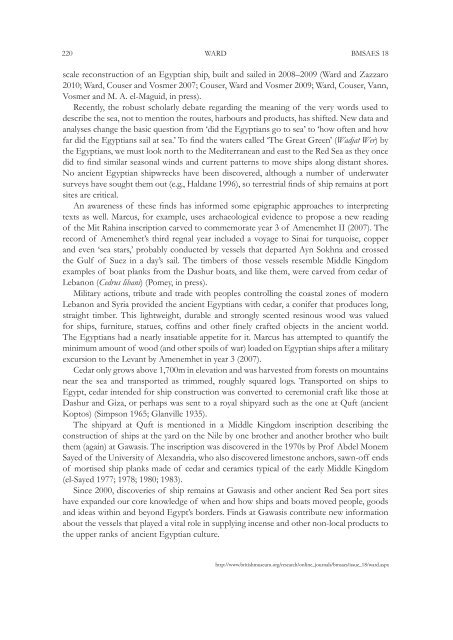Building pharaoh's ships: Cedar, incense and ... - British Museum
Building pharaoh's ships: Cedar, incense and ... - British Museum
Building pharaoh's ships: Cedar, incense and ... - British Museum
Create successful ePaper yourself
Turn your PDF publications into a flip-book with our unique Google optimized e-Paper software.
220<br />
WARD BMSAES 18<br />
scale reconstruction of an Egyptian ship, built <strong>and</strong> sailed in 2008–2009 (Ward <strong>and</strong> Zazzaro<br />
2010; Ward, Couser <strong>and</strong> Vosmer 2007; Couser, Ward <strong>and</strong> Vosmer 2009; Ward, Couser, Vann,<br />
Vosmer <strong>and</strong> M. A. el-Maguid, in press).<br />
Recently, the robust scholarly debate regarding the meaning of the very words used to<br />
describe the sea, not to mention the routes, harbours <strong>and</strong> products, has shifted. New data <strong>and</strong><br />
analyses change the basic question from ‘did the Egyptians go to sea’ to ‘how often <strong>and</strong> how<br />
far did the Egyptians sail at sea.’ To find the waters called ‘The Great Green’ (Wadjat Wer) by<br />
the Egyptians, we must look north to the Mediterranean <strong>and</strong> east to the Red Sea as they once<br />
did to find similar seasonal winds <strong>and</strong> current patterns to move <strong>ships</strong> along distant shores.<br />
No ancient Egyptian shipwrecks have been discovered, although a number of underwater<br />
surveys have sought them out (e.g., Haldane 1996), so terrestrial finds of ship remains at port<br />
sites are critical.<br />
An awareness of these finds has informed some epigraphic approaches to interpreting<br />
texts as well. Marcus, for example, uses archaeological evidence to propose a new reading<br />
of the Mit Rahina inscription carved to commemorate year 3 of Amenemhet II (2007). The<br />
record of Amenemhet’s third regnal year included a voyage to Sinai for turquoise, copper<br />
<strong>and</strong> even ‘sea stars,’ probably conducted by vessels that departed Ayn Sokhna <strong>and</strong> crossed<br />
the Gulf of Suez in a day’s sail. The timbers of those vessels resemble Middle Kingdom<br />
examples of boat planks from the Dashur boats, <strong>and</strong> like them, were carved from cedar of<br />
Lebanon (Cedrus libani) (Pomey, in press).<br />
Military actions, tribute <strong>and</strong> trade with peoples controlling the coastal zones of modern<br />
Lebanon <strong>and</strong> Syria provided the ancient Egyptians with cedar, a conifer that produces long,<br />
straight timber. This lightweight, durable <strong>and</strong> strongly scented resinous wood was valued<br />
for <strong>ships</strong>, furniture, statues, coffins <strong>and</strong> other finely crafted objects in the ancient world.<br />
The Egyptians had a nearly insatiable appetite for it. Marcus has attempted to quantify the<br />
minimum amount of wood (<strong>and</strong> other spoils of war) loaded on Egyptian <strong>ships</strong> after a military<br />
excursion to the Levant by Amenemhet in year 3 (2007).<br />
<strong>Cedar</strong> only grows above 1,700m in elevation <strong>and</strong> was harvested from forests on mountains<br />
near the sea <strong>and</strong> transported as trimmed, roughly squared logs. Transported on <strong>ships</strong> to<br />
Egypt, cedar intended for ship construction was converted to ceremonial craft like those at<br />
Dashur <strong>and</strong> Giza, or perhaps was sent to a royal shipyard such as the one at Quft (ancient<br />
Koptos) (Simpson 1965; Glanville 1935).<br />
The shipyard at Quft is mentioned in a Middle Kingdom inscription describing the<br />
construction of <strong>ships</strong> at the yard on the Nile by one brother <strong>and</strong> another brother who built<br />
them (again) at Gawasis. The inscription was discovered in the 1970s by Prof Abdel Monem<br />
Sayed of the University of Alex<strong>and</strong>ria, who also discovered limestone anchors, sawn-off ends<br />
of mortised ship planks made of cedar <strong>and</strong> ceramics typical of the early Middle Kingdom<br />
(el-Sayed 1977; 1978; 1980; 1983).<br />
Since 2000, discoveries of ship remains at Gawasis <strong>and</strong> other ancient Red Sea port sites<br />
have exp<strong>and</strong>ed our core knowledge of when <strong>and</strong> how <strong>ships</strong> <strong>and</strong> boats moved people, goods<br />
<strong>and</strong> ideas within <strong>and</strong> beyond Egypt’s borders. Finds at Gawasis contribute new information<br />
about the vessels that played a vital role in supplying <strong>incense</strong> <strong>and</strong> other non-local products to<br />
the upper ranks of ancient Egyptian culture.<br />
http://www.britishmuseum.org/research/online_journals/bmsaes/issue_18/ward.aspx
















